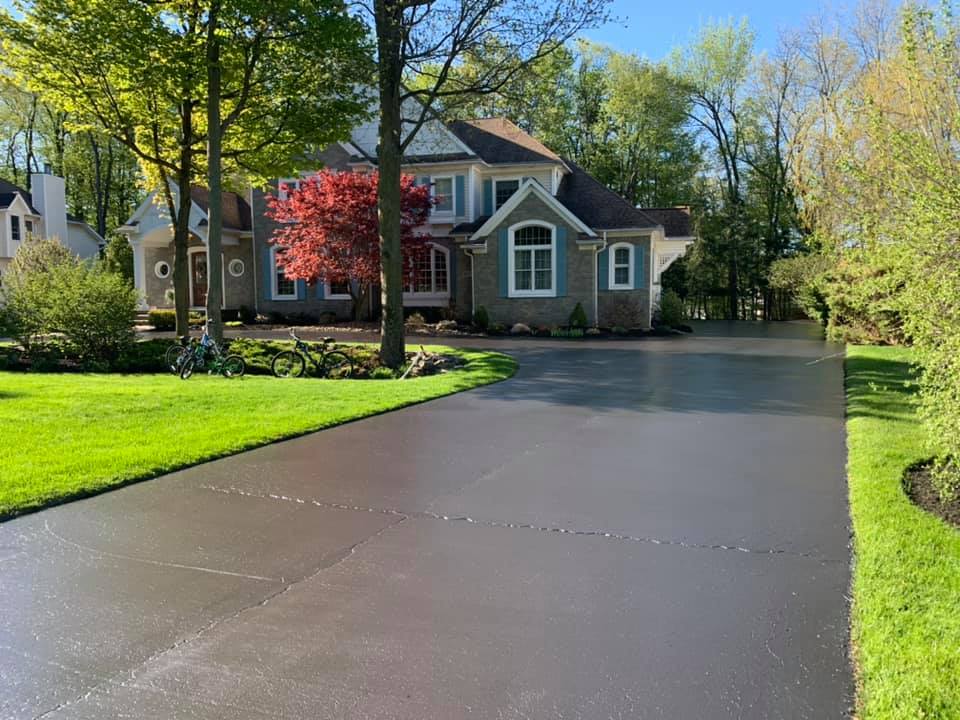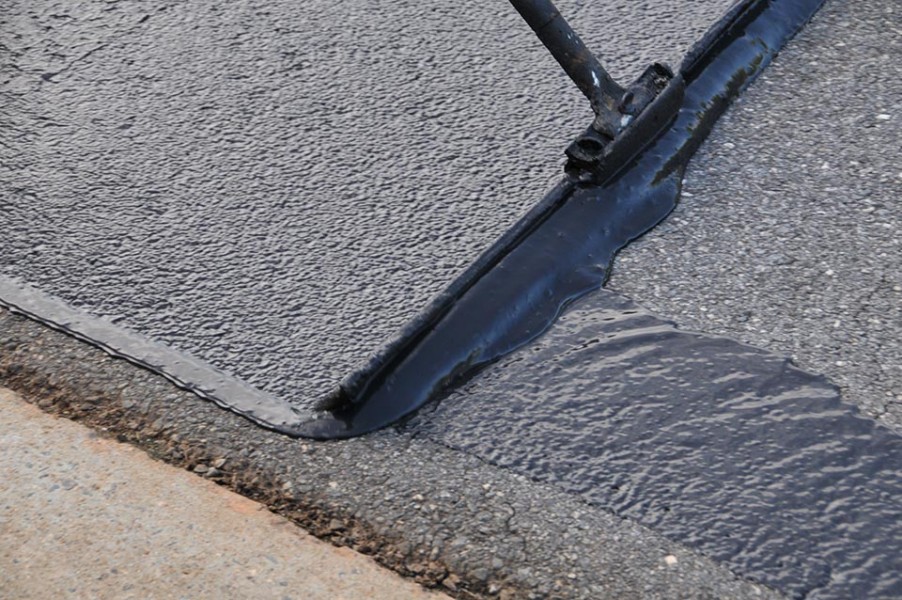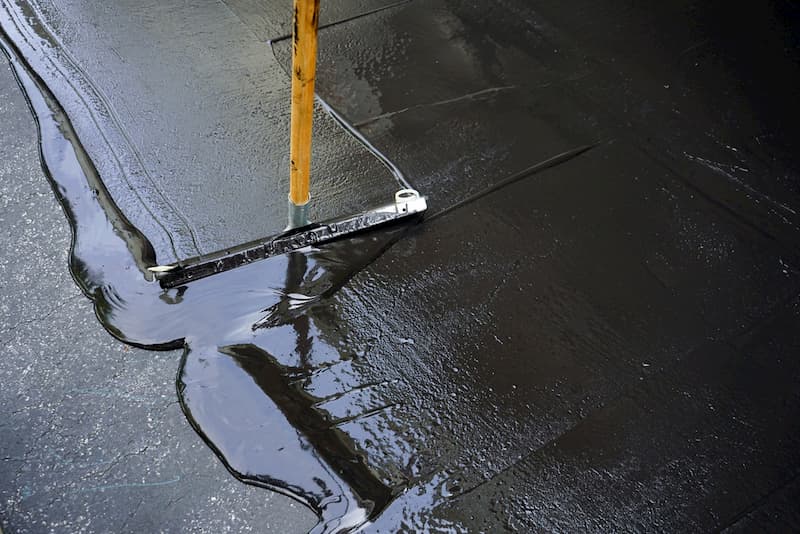Revitalize Your Building with Regrading and Asphalt Sealing Strategies
Revitalize Your Building with Regrading and Asphalt Sealing Strategies
Blog Article
Warm Mix Asphalt: A Lasting Remedy for Sidewalk
Warm Mix Asphalt (HMA) has actually arised as a leading lasting option for pavement options, providing a myriad of cutting-edge innovations and environmental advantages. As the need for environment-friendly construction practices expands, checking out the subtleties of HMA's sustainability can supply important insights right into the future of pavement remedies.
Ecological Benefits of Hot Mix Asphalt

Additionally, Warm Mix Asphalt assists to mitigate city warm island results. Its dark shade takes in sunshine, lowering the amount of heat showed back into the environment contrasted to lighter-colored pavements. This can decrease ambient temperatures in urban locations, lowering the need for air conditioning and ultimately decreasing energy consumption.
Additionally, Warm Mix Asphalt adds to improved stormwater administration. Its permeable nature permits water to penetrate the pavement and charge groundwater materials, lowering runoff and the danger of flooding. These ecological advantages make Warm Mix Asphalt a sustainable option for paving roadways and highways.
Power Efficiency in HMA Manufacturing
Is power effectiveness an essential consider the manufacturing of Warm Mix Asphalt (HMA)? Definitely. Energy plays a significant role in the manufacturing of HMA, influencing both price and environmental sustainability. One essential element of energy efficiency in HMA production is making use of cozy mix asphalt (WMA) innovations (commercial parking lot paving). WMA permits for the blending and placement of asphalt at lower temperature levels contrasted to typical warm mix asphalt, resulting in minimized power consumption throughout manufacturing. This procedure not just lowers fuel use yet also lowers greenhouse gas emissions, making it a much more eco friendly alternative.
Additionally, improvements in plant technologies have actually led to more energy-efficient HMA manufacturing procedures. Modern plants are created with features like recycled asphalt sidewalk (RAP) handling abilities, reliable burner systems, and boosted insulation, all adding to power savings. By enhancing power usage in HMA production, the market can lower its carbon footprint while maintaining high-quality sidewalk products. Power performance is, therefore, a critical consideration in ensuring the sustainability of Hot Mix Asphalt manufacturing.
Recyclability of Hot Mix Asphalt
The recyclability of Hot Mix Asphalt (HMA) is a critical element of its sustainability and lasting environmental influence. HMA is just one of the most recycled products in the USA, with over 100 million lots of redeemed asphalt sidewalk (RAP) being reused annually in new pavement building and construction. Recycling HMA uses numerous environmental benefits, such as minimizing the requirement for virgin products, decreasing energy consumption during production, and reducing the amount of waste sent out to landfills.
The process of reusing HMA entails grating the existing sidewalk, squashing it right into smaller sized pieces, and mixing it with brand-new accumulation and asphalt binder to create a recycled mix. This recycled mix can frequently do in addition to or also better than traditional HMA, while calling for fewer raw materials and producing reduced greenhouse gas discharges. By including RAP into brand-new sidewalk jobs, road agencies can save natural sources, decrease expenses, and minimize the environmental footprint of roadway building and construction and upkeep activities. Generally, the recyclability of HMA plays a substantial duty in advertising lasting practices within the pavement industry.

Long-Term Performance of HMA
Asphalt sidewalks demonstrate sturdiness and resilience over a prolonged duration, reflecting the long-lasting performance of Hot Mix Asphalt (HMA) The longevity of HMA can be connected to its capacity to endure rush hour loads, extreme climate condition, and the pop over to these guys effects of aging. Researches have actually revealed that well-designed and properly built HMA pavements can last for 20 years or even more with normal upkeep. The secret to maximizing the long-term efficiency of HMA hinges on using top quality materials, adhering to best techniques in building and construction, and carrying out reliable maintenance methods. Proper drain, routine examinations, and prompt repair work are necessary for protecting the architectural honesty of HMA pavements in time. In addition, advancements in HMA innovation, such as making use of polymer-modified binders and warm mix asphalt, have actually further enhanced the durability and durability of HMA pavements. By focusing on high quality building and maintenance methods, HMA remains to prove itself as a lasting and economical option for lasting sidewalk facilities.

HMA: Sturdiness and Sustainability
Demonstrating both durability and sustainability, Warm Mix Asphalt (HMA) has become a foundation in the building of durable pavement infrastructures - commercial parking lot paving. HMA's sturdiness stems from its capacity to endure hefty tons, harsh weather, and high website traffic volumes, making it a dependable selection for roads, highways, and airport terminal runways. The make-up of HMA, which usually includes accumulations, binder, and filler, plays a crucial duty in improving its longevity and resistance to tear and put on
Furthermore, HMA's sustainability lies in its recyclability and energy-efficient their explanation manufacturing procedure. The capability to recycle recovered asphalt pavement (RAP) in brand-new HMA blends decreases the demand for virgin products and minimizes the environmental effect of sidewalk construction and maintenance. Furthermore, the power performance of producing HMA lies in its lower blending temperature levels compared to other pavement products, leading to decreased energy intake and greenhouse gas emissions.
Final Thought
Finally, hot mix asphalt (HMA) provides a sustainable option for sidewalk with its eco-friendly attributes. HMA's recyclability, power performance in manufacturing, and lasting sturdiness make it an environmentally friendly option for road building. By preserving natural resources, lowering waste, and decreasing greenhouse gas discharges, HMA plays a crucial their website role in advertising sustainability in infrastructure advancement. Its capability to minimize metropolitan warmth island effects better underscores its relevance in developing environmentally mindful and durable sidewalk systems.
HMA is one of the most recycled products in the United States, with over 100 million bunches of redeemed asphalt sidewalk (RAP) being recycled annually in new sidewalk construction.The process of recycling HMA entails milling the existing sidewalk, crushing it right into smaller items, and mixing it with brand-new aggregate and asphalt binder to develop a recycled mix.Asphalt pavements demonstrate sturdiness and resilience over a prolonged period, showing the long-term efficiency of Warm Mix Asphalt (HMA) Furthermore, advancements in HMA modern technology, such as the use of polymer-modified binders and cozy mix asphalt, have additionally enhanced the resilience and long life of HMA pavements. The capacity to reuse reclaimed asphalt pavement (RAP) in brand-new HMA mixes minimizes the demand for virgin products and decreases the environmental effect of sidewalk building and construction and maintenance.
Report this page